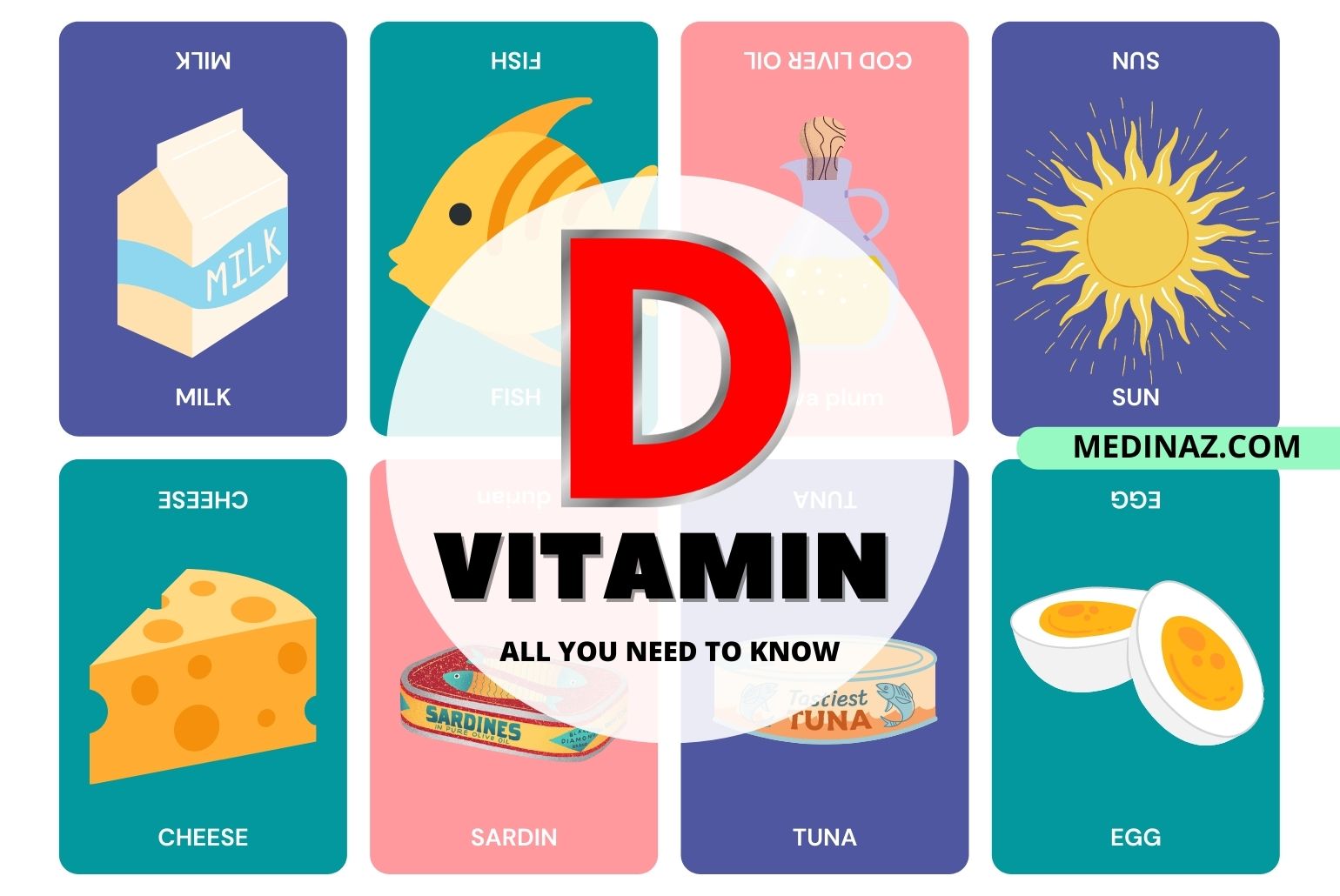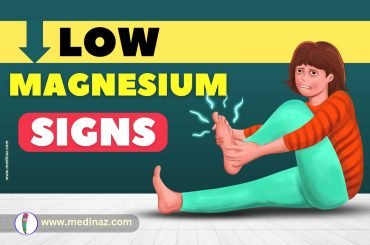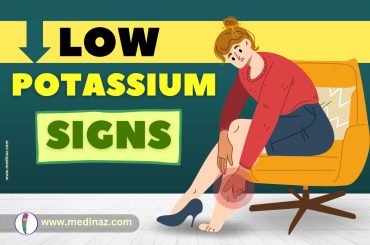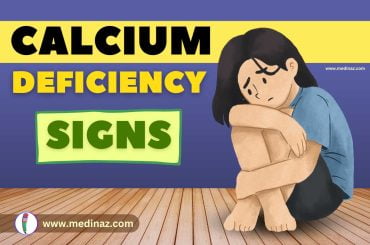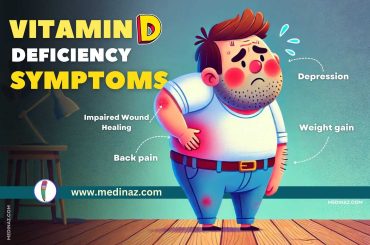Lets discuss about the vitamin D benefits, sources, deficiency and treatment
Vitamin D is a fat-soluble vitamin. It means that it dissolves in fats and oils. These fat soluble vitamins are absorbed along with fats in the diet and are stored in the body with a half-life of 1-2 days.
Vitamin D is also known by other names such as calciferol or sunshine vitamin.
There are two major forms of vitamin D, i.e vitamin D2 or ergocalciferol and vitamin D3, or cholecalciferol. Vitamin D2 is made naturally by plants, whereas vitamin D3 is made naturally by body when skin is exposed to ultraviolet radiation in sunlight (UVB). Both forms are converted to 25-hydroxyvitamin D in the liver. 25-Hydroxyvitamin D then travels through the blood to the kidneys, where it is further modified to 1,25-dihydroxyvitamin D or calcitriol, the active form of vitamin D in the body.
Table of Contents
Vitamin D deficiency:
Vitamin D deficiency means you do not have sufficient amount of vitamin D in your body for normal functioning. It is a unique type of vitamin because of the way it is produce in our body. It is actually produced by our skin by using sunlight.
Younger people and fair skinned individuals body convert sunlight into vitamin D in better ways than those who are darker-skinned and over age 50. Without sufficient vitamin D, bones can become thin, brittle, or misshapen.
Vitamin D sufficiency prevents rickets in children and osteomalacia in adults. Together with calcium, vitamin D also helps protect older adults from osteoporosis
Vitamin D function/importance:
- Vitamin D’s major function is to maintain normal blood levels of calcium and phosphorus. It helps in absorption of calcium from the blood and thereby helps in keeping our bones, and teeth strong
- It promotes bone mineralization along with other vitamins, minerals and hormones.
- Helps our muscles contract.
- Vitamin D helps nerves to carry messages between the brain and the body.
- It maintains normal cellular growth and function.
- It maintains healthy immune function.
- Vitamin D benefits include maintaining healthy immune function and preventing inflammation.
Vitamin D sources:
It is obtained from sun exposure, foods and supplements
It is produced from cholesterol in your skin when it is exposed to UV B rays from the sun. 15-20 minutes of sunlight for 3 days per week is generally sufficient to maintain adequate levels of vitamin D.
Food sources:
The current U.S. Daily Value (%DV) for vitamin D is 20μg (micrograms)
| Food | quantity | in mcg | in IU |
| Cod liver | 1 tablespoon | 34 | 1360 |
| Salmon(sockeye), cooked | 3 ounces | 14.2 | 570 |
| Tuna, canned in water, drained | 3 ounces | 1 | 40 |
| Mushrooms, white, raw, sliced, exposed to UV light | 1/2 cup | 9.2 | 366 |
| Milk vitamin-fortified | 1 cup | 2.9 | 120 |
| Trout (rainbow), farmed, cooked | 3 ounces | 16.2 | 645 |
| Sardines, canned in oil, drained | 2 Sardines | 1.2 | 46 |
| Liver, beef, cooked | 3 ounces | 1.0 | 42 |
| Egg yolk | 1 large | 1.1 | 44 |
| Cereal fortified with 10% of the daily value of vitamin D | 1 cup | 2.0 | 8 |
| Cheese, cheddar | 1.5 ounce | 0.4 | 17 |
These food items have decent amount of vitamin D; however, you would have to eat them almost every day to meet your daily requirement and get vitamin D benefits.
The only best way to meet your daily dose of vitamin D is through fish liver oil such as cod liver oil.
Vitamin D absorption depends upon factors like:
1. Season.
2. Time of day
4. Length of day,
4. Cloud cover,
5. Smog,
6. Skin
7. Melanin content, and
8. Sunscreen
These are among the factors that affect UV radiation exposure and vitamin D synthesis. Older people and people with dark skin produces less vitamin D from sunlight.
UVB radiation does not penetrate glass, so exposure to sunshine indoors through a window does not produce vitamin D.
Also you need to expose a large part of your body so that your body can produce ample amount of vitamin D from the UVB rays from the sun. Exposing only face and hands will produce much less vitamin D.
Vitamin D daily requirement as per age:
| Age group | IU | mcg |
| Infants (0- 12 months) | 400 | 10 |
| Children and adults (1-70 years old) | 600 | 15 |
| Older adults | 800 | 20 |
| Pregnant or breastfeeding women | 800 | 20 |
Signs and symptoms of Vitamin D deficiency:
- Fatigue and tiredness
- Bone pain or tenderness
- Muscle weakness, (Rickety myopathy or floppy baby syndrome), muscle aches
- Mood changes like depression
- Increased risks of fall and fractures in older adults (especially greenstick fractures)
- Hypocalcemia.
- Tetany
- Craniotabes (soft palate)
- Skeleton deformity: Cranial, spinal and pelvic deformities.
In children deficiency of vitamin D causes:
1. Rickets, i.e bone softening. Rickets is characterized by bone deformities due to incomplete mineralization. This results in soft and pliable bones and delay in teeth formation. The weight bearing bones bent to form bow legs (genu varum).
Knock-knees (genu valgum) or windswept knees, costochondral swelling (“ricket rosary” or “rachitic rosary”), Harison’s sulcus and pot belly.
2. Osteomalacia, i.e Bone thinning disorder
3. Osteoporosis, i.e decrease bone mineralization and increases bone fragility.
4. Muscle twitching
5. Light headedness
6. Too little vitamin D can pose serious health risks. Low blood levels of the vitamin have been associated with:
– Increased risk of death from cardiovascular disease
– Cognitive impairment
– Severe asthma in children
– Cancer
Medications that can lead to vitamin D deficiency:
Vitamin D may interact with many types of medications like:
1. Orlistat : It reduces the absorption of vitamin D from food and supplements, leading to low levels of 25 (OH) D levels
2. Statins : This medication reduces the cholesterol synthesis. As the vitamin D is derived from cholesterol, steroids may also reduce vitamin D synthesis.
3. Steroids : They are used to reduce inflammation. It can also reduce calcium absorption and then affects vitamin D metabolism.
4. Thiazide diuretics : It decreases urinary calcium excretion. Combination of these diuretics with vitamin D supplements (in which there is increase in intestinal calcium absorption) may cause hypercalcemia. This happens especially in older adults and individuals with compromised renal function or hyperthyroidism.
Diagnosis:
There are two blood tests to diagnose vitamin D deficiency.
The most common is the 25-hydroxyvitamin D, known as 25 (OH)D.
Range of Normal blood serum levels are 50 – 100 micrograms per decilitre.
Levels of 50 nmol/L (20 ng/mL) or above are adequate for most people for bone and overall health.
The levels below 30 nmol/L (12 ng/mL) are too low and might weaken your bones and affect your health.
Levels above 125 nmol/L (50 ng/mL) are too high and might cause health problems.
Vitamin D deficiency Treatment:
Deficiency of Vitamin D is primarily treated with vitamin D supplementation. One can also consider eating Vitamin-D rich foods in diet. Also as sunlight is the natural source of vitamin D, getting outside and exposing your skin to sunlight is important.
Too much of vitamin D can be harmful
Vitamin D greater than 375 nmol/L or 150 ng/mL can cause:
- Nausea
- Vomiting
- Muscle weakness
- Confusion
- Pain
- Loss of appetite
- Dehydration
- Excessive urination and thirst, and kidney stones.
Extremely high levels of vitamin D can cause:
Kidney stones which is associated with too much calcium from supplements.
Irregular heartbeat, and even death.
So, to get the proper vitamin D benefits intake it within normal limits
Prevention of vitamin D deficiency:
The best ways to prevent vitamin D deficiency and get the vitamin D benefits are:
1. 5–30 minutes of sun exposure, between 10 a.m. and 4 p.m., either daily or at least twice a week to the face, arms, hands, and legs without sunscreen usually leads to sufficient vitamin D synthesis.
2. Moderate use of commercial tanning beds that emit 2% to 6% UVB radiation is also effective.
3. Eating foods that are rich in vitamin D nutrient or are fortified with it.
What causes vitamin D deficiency?
Deficiency of vitamin D can occur due to many reasons like:
1. Darker skin and older people are less able to produce vitamin D from sunlight.
2. Use of sunscreen with SPF 8 or more blocks the vitamin D producing UV rays.
3. People who like in norther latitudes or areas of high pollution
4. Homebound individuals; people who wear long robes, dresses, or head coverings for religious reasons and people who work in night shifts, receives inadequate amount of vitamin D from the sunlight due to limited time of exposer.
5. Infants who are exclusively breastfeed gets only a small amount of vitamin d through their mother and is directly related to the mother’s vitamin D status. Often infant formulas are fortified with Vitamin D and if they are only breastfed then it might cause vitamin D deficiency. Vitamin D-fortified formula or milk is generally recommended.
6. People who have malabsorption syndromes like: bariatric surgery, cystic fibrosis, inflammatory bowel disease, crohn’s disease, and radiation enteritis.
Can you get too much of vitamin D from Sun?
One cannot get too much vitamin D from sunshine because your skin limits the amount of vitamin D it makes
What are the health effects of vitamin D deficiency?
Low levels of vitamin D can cause bones to become thin, brittle, or misshapen. Vitamin D sufficiency prevents rickets in children and osteomalacia in adults. Together with calcium, vitamin D also helps protect older adults from osteoporosis
What type of cancers can vitamin D reduce?
Many studies have shown that higher intake or blood levels vitamin D are associated with reduced risk of colorectal cancer. Although the available data are not comprehensive enough, therefore, new trials are being conducted.
A Visual Learning Platform

